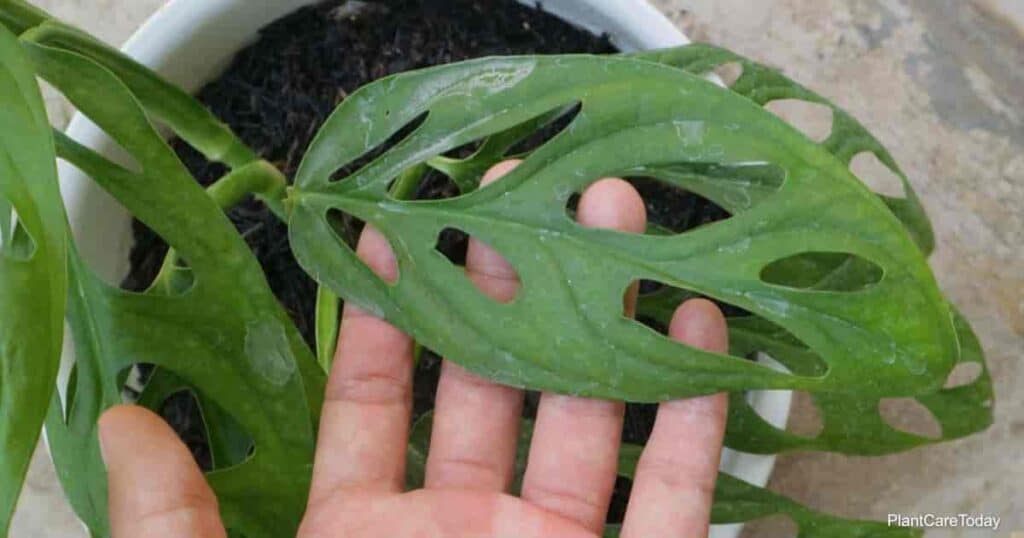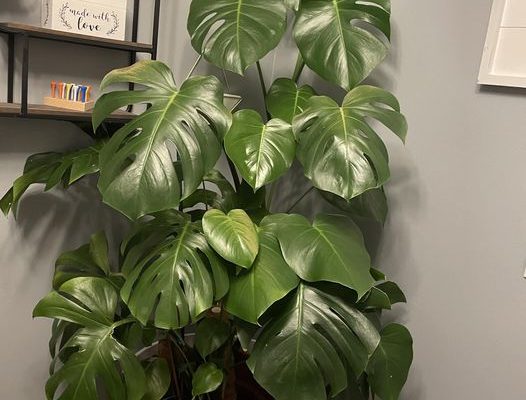Remember that your monstera comes from a warm, humid tropical setting. It needs high humidity to survive and thrive.
Yellowing leaves may be a symptom of dry air, which is common in a typical household setting.
Your plant will be happiest, with humidity levels ranging from 50% to 60% percent.
You can achieve this by misting your plant daily and keeping its container on a tray of pebbles with a bit of water in the bottom.
Don’t let the water touch the underside of your plants’ pot because this could lead to root rot.
Instead, the goal is to evaporate the water and raise the ambient humidity levels.
If you would have trouble remembering to mist and tend to a pebble tray, you may wish to use a humidifier in your plant room.
Pest Infestation Causes Yellowing Leaves
Plants kept in an incorrect environment or not well cared for are susceptible to pests, such as:
These pests may also sneak in on new plants and move onto healthy plants.
Any time you add a new plant to your collection, keep it in quarantine for a couple of weeks before putting it near your other plants.
This will give you plenty of time to determine whether the newcomer might be bringing in pests, bacteria, or fungal diseases.
If insect pests become apparent on your monstera, you may be able to blast them off with repeated sprays of water.
Use a horticultural soap spray, a neem oil concoction, or a permethrin spray to deal with them. Follow packaging instructions closely.
Be sure to clean up your plant area to eliminate any pests lurking on shelves, in plant saucers, on curtains, and so forth.
Even if you cannot see adult pests, eggs may be hidden.
Different Ways To How To Fix It Yellowing Leaves Of Monstera Adansonii
A Regular Watering Schedule Helps Prevent Yellow Leaves
If your monstera adansonii is developing yellow leaves higher up on the plant, or if newer, younger leaves are turning yellow, this is cause for concern. Very often, poor watering practices are to blame.
Check your soil. If it is soggy, you are overwatering. This can cause fungal growth and root rot, leading to yellowing and browning spots on leaves.
If the soil is arid, you are underwatering. This will cause leaves to dry out, turn yellow, and fall.
In this case, the solution is easy.
Here’s what you need to do:
- First, give your plant a good, deep drink.
- Then wait for the soil to become nearly dry before watering again.
In the case of overwatering, you may be able to solve the problem by simply withholding water and allowing the soil to dry out some before watering.
If the problem is long-standing, you are better off repotting into fresh soil and a new or sterilized container.
Note that monstera adansonii must have well-draining, light soil. The use of an orchid mix can help prevent problems with root rot.
Repotting is an excellent way to be sure of eradicating fungal infections.
You may also wish to give your plant a dose of anti-fungal remedy the first time you water after repotting.
If you repot, scrutinize the plants’ roots and trim away any that are mushy and brown.
In either case, trim away yellowed leaves using a sharp, sterile cutting tool.
Consistent Lighting And Temperature Helps Leaves Stay Green
These jungle plants prefer a consistent temperature between 65° and 80° degrees Fahrenheit.
Lower temperatures will interfere with the growth of the plant and will cause leaves to turn yellow and drop.
Higher temperatures may stress the leaves, causing them to dry and turn yellow.
If your monstera is indoors, place it in an area without exposure to hot or cold drafts from heating or cooling vents.
Also, keep it away from temperature fluctuations such as doors opening and closing.
If the plant is outdoors, bring it in or cover it if the forecast drops below 55° degrees Fahrenheit.
Understand that the plant can only tolerate this low temperature briefly.
Don’t place your plant close to a window where harsh sunlight can cause excessive heat and leaf burn.
A position too close to a window can also cause leaf yellowing due to cold air coming through the panes.
Always Cut Off Yellow Leaves
Cut them off no matter what is causing your monstera adansonii to develop yellow leaves. The leaves cannot recover. As long as they are on the plant, they drain its energy and create potential habitats for pests, fungus, and bacteria.
Keeping your plant pruned neatly is essential in treating and preventing various problems.




